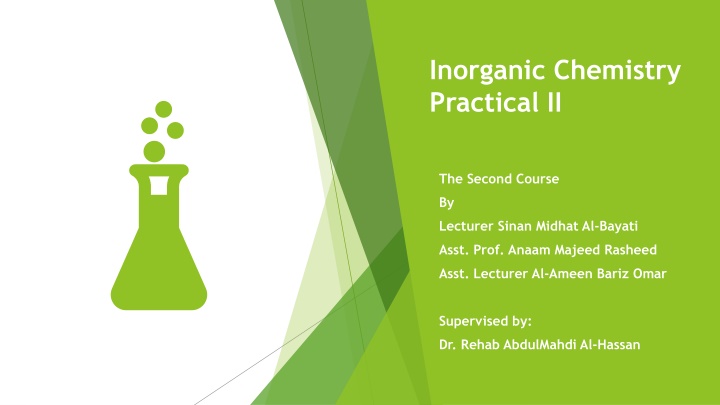
Inorganic Chemistry Practical II: Preparation of HexaThiourea Lead (II) Nitrate
Explore the experimental procedure for preparing HexaThiourea Lead (II) Nitrate, including the required reagents, steps, and questions on complex stability, hybridization, oxidation state, and more.
Download Presentation

Please find below an Image/Link to download the presentation.
The content on the website is provided AS IS for your information and personal use only. It may not be sold, licensed, or shared on other websites without obtaining consent from the author. If you encounter any issues during the download, it is possible that the publisher has removed the file from their server.
You are allowed to download the files provided on this website for personal or commercial use, subject to the condition that they are used lawfully. All files are the property of their respective owners.
The content on the website is provided AS IS for your information and personal use only. It may not be sold, licensed, or shared on other websites without obtaining consent from the author.
E N D
Presentation Transcript
Inorganic Chemistry Practical II The Second Course By Lecturer Sinan Midhat Al-Bayati Asst. Prof. Anaam Majeed Rasheed Asst. Lecturer Al-Ameen Bariz Omar Supervised by: Dr. Rehab AbdulMahdi Al-Hassan
Experiment No. (3) Preparation of HexaThiourea Lead (II) Nitrate [Pb{Cs(NH2)2}6](NO3)2:
Thiourea is an organosulfur compound with the formulaSC(NH2)2. It is structurally similar to urea, except that the oxygen atom is replaced by a sulfur atom, but the properties of urea and thiourea differ significantly. Thiourea The Required Reagents: 1. Lead nitrate Pb(NO3)2 (0.25 gr). 2. Thiourea (NH2)2-C=S (0.33 gr). 1. Distilled water.
Procedure: Dissolve (0.25 gr) of lead nitrate Pb(NO3)2in (5ml) of distilled water in beaker then heat it. Dissolve (0.33 gr) of thiourea (NH2)2-C=S in (5 ml) of distilled water and then heat it Mix the two solutions in one beaker and then cool the mix with ice bath; this will lead to produce separated colorless crystals in the form of needles. Filter the solution, dry the crystals and weight out them. Calculate the percentage of the complex.
Questions: Is the complex output stable? Why? What is the hybridization and structure formula of this complex? What is the structure formula of this urea? Calculate the oxidation state of Lead in this complex. What is the basic idea of this experiment? Explain how thiourealinked with Lead, and draw the structure of this complex. Calculate the theoretical mass obtained for complex and the percentage of it. Give the properties of thiourea.
The Fifth Group (V): The Nitrogen Group The Elements Symbol Electronic Structure Nitrogen 7N 2[He] 2s22p3 Phosphorous 15P 10[Ne] 3s23p3 Arsenic 33As 18[Ar] 3d104s24p3 Antimony 51Sb 36[Kr] 4d105s25p3 Bismuth 83Bi 54[Xe] 4f145d106s26p3
Questions: Give the oxidation state for N, and P, with examples. Explain the increase of electropositive from N Bi. Phosphoric acid H3PO3, and hypophosphorous acid H3PO2, give the structure of each acid and explain pH group that do not reactwith NaOH. Why oxidation state (+3) becomes more stable from N Bi? Give the structure of N2, PF6-, PF3. Why the stability of hydrides decrease in the series: NH3, PH3, AsH3, SbH3, and BiH3






















